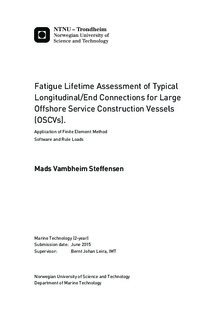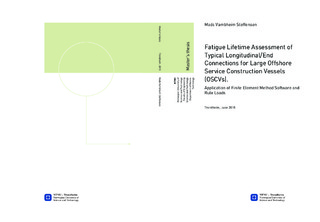| dc.description.abstract | In the last decades there has a major development of the Offshore Service Construction Vessels (OSCV) where high tensile steel has been introduced to increase the dead weight, but also to increase the allowable stress level. In the same period the average main dimensions have increased, leading to greater wave induced hull girder moments. This development has made it interesting to check the expected fatigue lifetime of the structure.
In this thesis, the aim is to assess the expected fatigue lifetime of a longitudinal stiffener (HP-profile) at a typical end support for an OSCV designed by VARD Design AS. The analysis has been according DNV standards with special focus on the Classification Notes No. 30.7 Fatigue Assessment of Ship Structures.
As a part of the work, the operational pattern for OSCVs has been investigated to determine - in the best possible way - the long term sea environment, in addition to how frequently the general OSCV is at sea where dynamic loading occurs. The result showed that the vessel spend between 60 and 70 % of the time at sea, and that the long-term sea environment is fairly difficult to determine in the design phase. However, worldwide trade assumption appears more correct than North Atlantic assumption, based on the fact that these vessels operates when the significant wave height, Hs is small.
Regarding fatigue lifetime of the longitudinal at a typical end support, the analysis showed that the main deck longitudinals are more critical with respect to fatigue compared to a bottom longitudinals, since the latter are subject to mean stress effect, i.e. the stress cycles are in compression. When applying the operational profile, the calculation shows that the fatigue life of a longitudinal in main deck is about 37 years when assuming North Atlantic environment and 20 years service life.
The studies have also shown that detail design is important for preventing fatigue damage. Using a soft (radius-ed) bracket will provide lower hot spot stress (/stress concentration factor) compared to a straight edged bracket. | |

